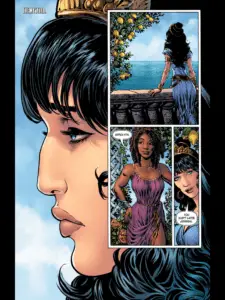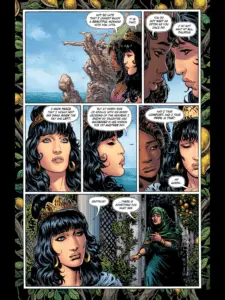Several months ago, another writer here at The Fandomentals covered just how problematic the cover of Wonder Woman issue #15 was with its depiction of an implicitly medicated Diana secured with a straight jacket in a padded room. Just this past month, I covered the lead-in issue and all the ways that it dropped the ball when it came to setting up the situation. Now that we have gotten to issue #15 itself, Part I of “The Truth”, all I can do is shake my head as it hits the low notes we dreaded.
To start with, Diana is apparently being held by the mental institution because they believe that she is suffering from the delusion of being Wonder Woman. Consider all the ways that this is messed up: 1) Steve Trevor did not tell them who she was when he dropped her off, or why, which makes him an outright villain my eyes; 2) the staff apparently did not perform any type of identification verification and checked her in on Steve’s say-so, which makes them incompetent at best or downright criminal at worst; 3) since the doctors believe she is suffering from a delusional disorder of some type they are not treating her for the psychological trauma which has actually forced her into a catatonic state, which means that everything she goes through here will only make her personal situation worse.
Diana was, quite literally, locked up in a mental institution solely on the word of a man with no legal authority, he did purely so that she would be kept out of his way. AND she has been misdiagnosed, so she is not in a position to actually receive the help she needs to treat her problems.
Holy carp, this is a serious problem. A serious real life problem. Psychiatric institutions around the world have a horrid history of being used to control and abuse women, political dissidents, and minorities when they attempt to buck the social order. Throughout history, women in particular were often committed purely on their husband’s or father’s word that they were “crazy”. They would then be medicated (or lobotomized) with no other medical diagnosis. Even now this problem has not been completely stamped out (well, the ‘lobotomy’ part generally has been, but not the involuntary commitment for personal, criminal, or political reasons).
Leaving aside the appalling way she wound up here, the fact that the doctors have not been informed what her problems are means that everything they do to try and help will be self-defeating and likely damaging. Anti-psychotics and mood stabilizers—which are the traditional medication families used to treat schizophrenia, dissociative identity disorder, bi-polar disorder, etc., any of which could explain a delusion like they believe she has—are downright dangerous when misapplied. For somebody who seems to be suffering from post-stress catatonia I don’t even want to think about what they will do to her mind and body.
It would be one thing if this was meant to highlight these problems in the real world, a socio-political commentary mixed in with the action/adventure of the series. But the comic does not step in that direction. The comic passes no judgement on Steve for the cold way he flat-out abandons Diana, nor does it show other patients in the hospital as being likewise misdiagnosed or mis-medicated to show that this is a widespread problem. It lets Steve continue to be the hero in his adventure. The hospital, on the other hand, is generically bland when Diana is pushed around the garden and speaking with a maybe-hallucination/maybe-deific snake coming out of her arm.
As always, these scenes could have been used to heart wrenching effect if handled differently. What if Steve Trevor knew that Wonder Woman was an easy target, and so he kept her true identity a secret in order to hide her? He could have clued in one of the doctors at this facility to the truth so that they could begin honest treatment, but still kept the rest of the facility in the dark. To prevent word getting out, they came up with the, “She’s crazy and thinks she’s Wonder Woman” explanation. That simple switch changes “Steve dumped her with an ignorant staff without bothering to explain anything” to “Steve is trying to secure the best help he can for her while he is away and she is in danger”.
Honest psychological treatment is still an immensely personal, harrowing experience, and going through this with Diana could have been a compelling, powerful story that has never been explored in comics to its full depth. The need to keep her identity a secret could have been used to reflect the real-life stigma against psychiatric treatment and the way some people suffer in silence rather than admit that they need help and face an uncaring society. The way her true identity is dismissed could have commented on the way people with mental illness are dismissed when they face other issues (like other physical ailments or treatment) since everybody “knows” they are crazy. It could have shown that even the strongest of us, even those who are not ‘supposed’ to need help, sometimes do need help. Not because of a magical monster harrowing them, but just because they have been through a terrible ordeal and are still coming to terms with what it means.
Instead, the scenes of Diana uncaringly stuffed out of the way pulls down the entire arc, tainting the rest of the issue by association. Which is a pity, because the rest of the comic is actually not that bad on its own.
We finally see Etta Candy again, whose bizarre absence last issue was confusing and so noticeable that it actually made me wonder if they were trying to hint that she was actually dead or otherwise out of commission. Not only do we see Etta return, but we see her and Barbara Ann Minerva together. It’s great to see them build on the relationship that we see starting in the “Year One” arc.
The simple fact that Barbara calls Etta “love” and that they fall into flirt-banter so smoothly shows that these two have had a relationship. In “Year One” only got the beginning of the banter. So far this issue, they are still feeling their way into whatever it is they are going to have, and as great as these scenes are, there has been the possibility that maybe nothing happened at all between them before Barbara was corrupted by dark powers. Sometimes people never act on their attractions and feelings. Here it becomes apparent that, even if Barbara eventually was taken in by darkness, these two got together first, and they still feel for one another. Strongly. Which is beautiful.
This scene also features Steve picking at Barbara. He’s angry, resentful, and more than a little suspicious that she might be involved in what is currently going on because of her history as the Cheetah. Here is where we finally get some comic-critique of Steve, since through Etta’s reaction he is presented to the reader as barely toeing the line, or even as being over the line in his treatment of Barbara. We need more of this type of character presentation for him; he behaves poorly because it makes sense that he lose control given the circumstances. Heck, I would probably act even worse in this situation. So at least the comic does not try and frame that as right.
We also get a glimpse of Themyscira, and it does seem to be the real Themyscira. This is not an illusion or deception being cast to misdirect Diana. This is really it, and that means that the people there are the real Amazons. Diana’s mother, Diana’s friends, and the people and culture that we (the readers) have not seen in the “present” since before Nu52 began in Flashpoint. Fitting, then, that the first woman we see is Queen Hippolyta, soon joined by her lover, Philippus.
These are the perfect two Amazons to reintroduce us to the real Themyscira: Diana’s mother and step-mother, the Queen of the Amazons and their General. They’re probably two of the best known of Diana’s supporting characters outside of the Wonder sidekicks. Their conversation is perfect as well. Hippolyta gazing out over the sea, which Philippus interprets as her hoping that Diana will return, but which Hippolyta claims is actually her just appreciating all that Diana is doing out in ‘Man’s world’. It is a glimpse of the familial bond between Hippolyta and Diana, the romantic bond between Hippolyta and Philippus, and the bonds of duty and caring that are part of the Amazon culture. This scene bring us back to the Amazons and sets up the next part of their story, which seems to include the gnarled, ancient tree that has figured so prominently in the past.
Overall, this issue is weighed down by its poor handling of Diana’s situation. It takes her out of her own story and makes her an emotional target for Steve Trevor to mope about while he is off being the hero. It also fails to compensate by presenting a real emotional punch in what we do see of her. Her situation touches on a lot of real-world issues that are present and serious right now without seeming to recognize all that they import, or how they could be adapted to help tell this story. This issue, and the preceding parts of this arc, are a huge disappointment and not what I have come to expect from the past quality of Greg Rucka’s writing.
Images courtesy of DC Comics.
Wonder Woman #15 Credits
Writer: Greg Rucka
Artist: Liam Sharp
Colorist: Laura Martin
Cover Art: Liam Sharp & Laura Martin






